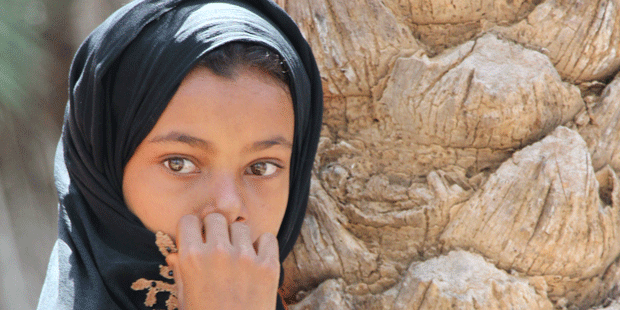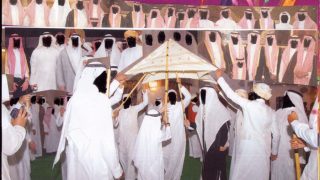For the clever Sheikhs who run the United Arab Emirates, jumping headfirst into Saudi Arabia’s ill-considered invasion of Yemen was clearly a business decision, writes Abdelhadi Khalaf. Once they had secured their hold on a few ports, airports, and developable tourist destinations, they stopped participating in the military operations and got down to the business of securing their new assets.
When Saudi Arabia launched an attack on Yemen in March 2015, dubbing it ‘Operation Decisive Storm,’ media enthusiasm for the war inflated both the military operation’s immediate prospects, and its long term strategic implications.
Decisive Storm was described as the beginning of a new era for the region, in which a so-called “Salman Doctrine” would place the entire region under the protection and security guarantee of the Saudi King and his fellow Gulf Monarchs, in particular the monarchs who head the principalities of the United Arab Emirates.
In practice however, the Saudis and their Emiratis partners have very different perspectives on the war in Yemen.
The Saudis had planned the war to inaugurate a new “Saudi Age” led by the son of King Salman at the head of a coalition of dozens of Arab and Muslim countries. As well, the Saudis have a clear strategic interest in keeping Yemen under their sway and within their military influence. The countries after all share a 1,500 kilometer border, widely used for smuggling weapons, drugs, and people. And for the Saudi labor market and even their armed forces, Yemenis were long seen as a human reservoir that they could not afford to disconnect.
Unlike Saudi Arabia, the Emirates did not experience Yemen’s pre-invasion political agitation as a direct threat. Rather, they saw a quick war in Yemen as a ticket to dividing the spoils after the war, and perhaps of improving the Emirati state’s prospects by extending its regional influence politically and economically. It was for these two reasons, and not for ‘empire-building’ (as in the case of the Saudis) that the leaders of the Emirates were the most enthusiastic of all the participants in the ‘Arab Coalition, led by Saudi Arabia and conducted by the armed forces of the UAE,’ as their own media liked to say.
Beyond participating in air strikes and the maritime blockade against Yemen, the Emirates also took a leading role in the launching of ground attacks. UAE troops, in addition to foreign and Yemeni troops paid from the UAE treasury succeeded in taking control of vast portions of Yemeni territory in the south of the country.
But when it became clear that Decisive Storm was not going as expected, and that the invasion would not meet its objectives within a week or month, as the Saudis had expected, the war’s participants began to take divergent decisions. As the war gradually transformed into a quagmire, the UAE ceased offensive operations; meanwhile the Saudis were unable to find a way out of an increasingly absurd war, instead escalating their own military operations in spite of the economic, political and ethical costs.
After taking control of a number of strategic sites, including the city of Aden’s maritime port and airport, the UAE halted its ground invasion of Yemen. In June 2016, in fact, it publicly announced, to the surprise of its partners, ‘the end of all Emirati military operations in Yemen,’ and a transition to “monitoring the political situation in order to empower Yemenis in the liberated areas.” (in Emirates Al Youm, 6/16/2016).
Reactions to the UAE decision varied. Some, underlining the hostility of Emirati leaders toward the Muslim Brotherhood, worried that their decision to end the offensive now would in fact strengthen the Brotherhood’s local affiliate, the Islah Party of Yemen, which functioned as Saudi Arabia’s local political proxy in Yemen. Others however, took the UAE’s move as a clear indication that it was simply double-crossing its partners by taking control of the part of south Yemen it had conquered.
By participating in the opening moves of Decisive Storm, as the war in Yemen was euphemistically termed, the UAE had guaranteed itself investment opportunities in whatever Yemeni territory it could control.
One of those opportunities, and perhaps the most important prize of all, has already been announced: the tourism development of the island of Socotra. 45,000 Yemenis live on this 1,400 square mile island in the Arabian sea. The UN designated it a Unesco World Heritage site, calling it a “site of universal importance because of its biodiversity, with rich and distinct flora and fauna.”
The same week that the Emirates announced the end of their participation in the Yemen war, they unveiled plans to launch several development projects in the Socotra Archipelago, calling them ‘the miracle that the people of Socotra have long dreamed of.’ A miracle that, interestingly, is remarkably similar to a competing ‘development miracle’ that the sheikhs of neighboring Qatar had been publicly planning for the Socotra Archipelago before the armed forces of the UAE seized the region during Decisive Storm.
Among the UAE’s development proposals, two in particular seem likely to have long term and unfortunate repercussions.
First is the construction of the Airport of Socotra, an arrival point for thousands of tourists headed to the resorts which will be built throughout the archipelago, transforming it into a top tourism destination to rival other resorts in the Indian ocean. If the environmental devastation wrought in Emirates is any indication, this project and the attending developments will inevitably destroy the unique ecosystem of the Socotra Archipelago.
Furthermore, the construction of the airport and the tourist resorts, and the infrastructure to support them will require displacing a large part of the local population, probably expelling people from the most desirable places and islands in order to make room for western tourists, though they may be resettled on other parts of the archipelago.
The UAE’s second project in its part of the south of Yemen is the creation of a special military base in Yemen, to house 2,300 Yemeni troops, originally inhabitants of the archipelago who will be taken to the Emirates for training before being shipped back to the archipelago to head up a local military task force. (in Al Ittihad, 6/16/ 2016).
What exactly the locals think about this Socotra special military unit is unknown, likewise the opinion of President Hadi and the various parties who control parts of Southern Yemen. However the proposal appears consistent with special military units set up by the emirates in other parts of southern Yemen. In both Hadramout and Aden, the UAE also created special military units independent from each other and from any Yemeni counterpart. Units trained financed and led entirely by Emiratis, in order to preserve and advance Emirati interests in Yemen.
The Emirati initiatives have raised suspicions that the Saudi-UAE plan is to divide the country into statelets which can be handed over as booty to Gulf monarchies.
Whatever is the true aim of these special military units trained and financed by the Sheikhs of the UAE, they are nothing new for the region, and indeed not even new to the Sheikhs themselves.
Back in 1951, the British colonial authorities who held sway in the peninsula created and financed the Trucial Oman Scouts, a military unit drawn from the sons of the poor and marginalized people of the Emirates, trained by British officers. The mission of the Scouts was to “protect oil exploration teams, keep the peace between the tribes, and combat the smuggling of weapons and the slave trade.” Twenty years later, these British military unites, the Trucial Oman Scouts, would become the nucleus of the UAE’s armed forces.
Translated by International Boulevard




